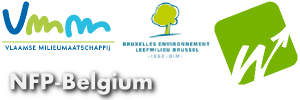Document Actions
National and regional story () - Increased transport flows and no room for new transport infrastructure
Urbanisation and transport in the Flemish Region of Belgium
Key message
Flanders is an urbanised region with an extensive transport infrastructure. ’Flanders in Action’ is the main Flemish policy plan looking forward to 2020.
Figures
Figure 1: Share of transport in the environmental pressure of various themes (Flanders, 2008)

Fullscreen image Original link
The Flemish region has a relatively small surface (13 522 km²), but belongs to one of the most populated (455 inh/km² in 2008) regions in Europe. A gradual population increase is estimated together with further ageing. Furthermore, the composition of households is changing towards singles and smaller families. The demographic trends have an impact on consumption patterns, mobility, accommodation and energy needs.
The Flemish territory is heavily urbanised and is composed of a chain of smaller and larger urban areas. This ‘suburbanisation’ combined with the spread of economic activity is an important spatial characteristic of Flanders. The built-up area (26,2 % in 2009) increases yearly. In several zones this leads to heightened competition between different land uses and an increasing fragmentation of open spaces.
Flanders is a productive and industrialised region. In 2008, GDP per capita exceeded the EU 27 average by 20 %. The Flemish economy is strongly focused on the export of goods due to its central position within western Europe. However, freight transport is growing faster than the regional GDP in Flanders.
Emissions related to the production of goods have a strong environmental impact. Belgian resource and energy use can to a large extent be allocated to the Flemish region. Flanders succeeded in the decoupling of the emissions of a lot of pollutants from economic growth. However, the need for resources and the trends in energy consumption match the GDP-evolution (where only relative decoupling is apparent). The regional energy intensity is among the highest in the EU, due to the presence of energy-intensive chemical, iron and steel sectors and the high-energy use of buildings.
Flanders has a very extensive transport infrastructure, which makes it an easily accessible region. The Flemish seaports contribute to the Flemish GDP for nearly one-tenth. The density of roads (5.15 km/km² in 2007) and railroads (0.13 km/km² in 2007) is among the highest in Europe. Several airports are available on Flemish territory or within close proximity.
The use of this infrastructure for the transport of passengers and goods has increased. In the period 1995-2008 road transport flows (vehicle kilometres) increased by 19 %. Globalisation and the open European borders led to an increase in foreign freight transport by road. Further increases are expected for passenger and freight transport.
Flanders hardly has space to spare for new transport infrastructure. Thus, better use must be made of what already exists by changing transportation modes – both for the conveyance of passengers and goods. The relentless volume of road traffic has several disadvantages: congestion, unacceptably high numbers of traffic victims, too much traffic noise, and excessive emissions of pollutants (CO2, VOS, NOx and particulate matter) into the atmosphere. Flanders needs to promote more environmentally friendly transport modes, especially within the urban areas. Therefore, it encourages public transport and carpooling and stimulates the installation of diesel particulate filters on older diesel vehicles (Euro 3 standard).
Flanders has the ambition to become a genuine intelligent pivot for transport and logistics in Europe (‘Smart logistics Europe’). The authorities, industry, and research institutes are collaborating in this respect to design ICT applications for traffic management and for citizens and businesses. Traffic management is integrated into a broader approach for a more efficient mobility. Attention is given to ’multi-modal junctions-, places where passengers can switch from one mode to another or where goods (containers) can be transferred to another mode. Intelligent road pricing can also contribute to a more efficient use of transport infrastructure.
More details can be found in the programme of the Flemish government ’Flanders in Action’ in which Flanders is looking forward to 2020 with the aspiration of becoming one of the best performing European regions.
The environmental profile shows the contribution of the transport sector to the environmental pressure in Flanders. The ten biggest shares in the use of natural resources and emissions are shown.




